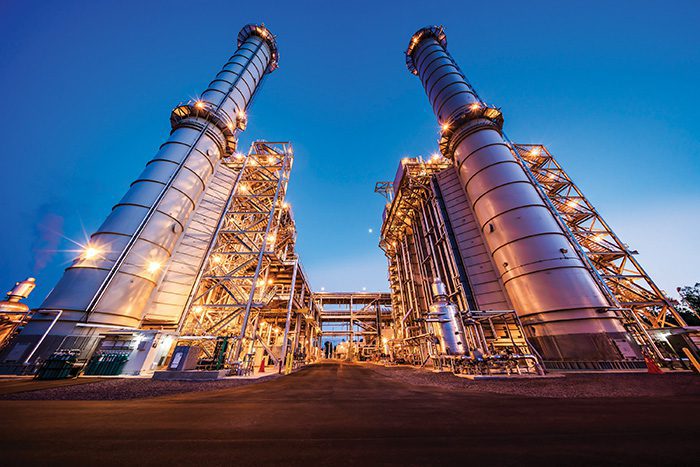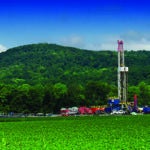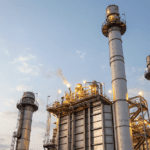Recent reports from groups analyzing U.S. power generation note how states near the nation’s largest shale plays are expected to bring significant new natural gas-fired generation online over the next few years, despite concerns about recent market volatility that sent gas prices to their highest levels in more than a decade.
With a long-term outlook favoring natural gas as U.S. coal stockpiles continue to dwindle, utilities are moving forward with plans to add gas-fired generation capacity through 2025, according to Colorado-based BTU Analytics, a FactSet Company. Andrew Bradford, Vice President Power for FactSet, told POWER on Dec. 14 his group “is tracking 32.3 GW of natural gas-fired power plants with in-service dates through 2025 that are in advanced stages of development.” Bradford said “14.2 GW have a status of under construction, 3.4 GW are at pre-construction, and 14.7 GW have a status of advanced permitting.”
Bradford said the PJM and MISO regions, along with the U.S. Southeast, are the most-active new-build regions with 15.8 GW, 3.8 GW, and 6.2 GW, respectively, planned to come online over the next few years.
“It is important to think about all of these different generation types as backstops for each other,” said Sarp Ozkan, Senior Director of Power & Renewables Analytics at Enverus. “So, as the price of natural gas as the fuel increases, the backstops like coal and fuel oil become more competitive and are called upon to serve the load. As the price of natural gas as the fuel decreases, coal and fuel oil get moved further away from being in the money.”
Ozkan on Tuesday told POWER that “natural gas provides two distinct advantages. One advantage is that it is dispatchable, making it necessary for peak demand periods. Additionally, it is the cleaner in terms of emissions profile than coal and fuel oil.”
EIA Expects 6% Rise in Gas-Fired Capacity
Though not as bullish as the BTU Analytics’ numbers, the U.S. Energy Information Administration (EIA) in its Monthly Electric Generator Inventory published in November said it expects 27.3 GW of new natural gas-fired generation capacity to enter operation from 2022 to 2025, a 6% increase above the current 489.1 GW of U.S. capacity as of August 2021. The agency said its data shows that most of the planned new gas-fired capacity will be built in the Appalachia region, which includes the Marcellus and Utica shale plays across West Virginia, Pennsylvania (Figure 1), and Ohio. Those plays accounted for more than one-third of all U.S. dry natural gas production in the first six months of this year.
The Salt River Project in Arizona recently approved an expansion of the Coolidge Generating Station, with a plan to add 16 gas-fired turbines to the site. Go here to read more about that project.
“Proximity to supply is always important. It avoids high transport costs and allows for a more competitive fuel price,” said Ozkan. “In cases where the natural gas demand from a power plant is behind a constraint in the natural gas infrastructure and in close proximity to the best resources [for example: the core of the Marcellus, Utica, or Haynesville], natural gas prices will be the most competitive and keep the plant in the money against the backstops.”
Illinois, which has pipeline access to Utica and Marcellus gas, accounts for 3.8 GW of new gas-fired capacity scheduled to come online over the next four years, according to EIA. The group said other states utilizing gas from those plays include Michigan, with 3.2 GW of new capacity planned; Ohio (2.9 GW); and Pennsylvania (1.9 GW).

Florida also has 3.2 GW of new gas-fired generation capacity scheduled. Regional pipeline networks for natural gas have continued to expand in that state. EIA said five new gas-fired plants are expected to enter commercial operation over the next four years in Florida, where utilities also are rapidly expanding their solar power generation capacity.
New Ohio Plant Comes Online
One of the most recent new plants to enter commercial operation is the 1,182-MW South Field combined cycle gas turbine plant (Figure 2) in Ohio. Bechtel completed engineering, procurement, and construction work at the new $1.3 billion facility in October.
Not every project sited in recent years is moving forward, though, and some gas-fired power plant projects have been canceled. Robinson Power, a Pennsylvania company with plans to build a 1-GW facility known as Beech Hollow, recently withdrew its request for a permit from the state’s Dept. of Environmental Protection (DEP). The company had altered plans for the project several times, though each of those designs had been approved by the DEP despite opposition from environmental groups.

The 1.1-GW Charles City Combined-Cycle Gas Turbine Plant in Virginia, known as C4GT, was canceled in July. The nearby 1.6-GW Chickahominy Power Station, though, located about one mile from the C4GT project, remains under development, despite opposition to both the plant and an accompanying 83-mile gas pipeline.
‘Natural Gas Generation’s Reliability is Key’
Bradford told POWER that gas-fired generation, particularly in areas with ready access to a steady supply of natural gas, will remain important even as more utilities and governments support growth of renewable energy.
“As much as some environmentalists would like to accelerate to a net-zero emission future without natural gas, it is hard to see how that happens,” Bradford said. “What Winter Storm Uri in ERCOT in February 2021 highlighted yet again is in the energy industry redundancy and reliability at scale are paramount. Until a low-cost, large-scale, long-duration battery comes to market, natural gas power generation’s reliability at scale is key.”
Natural gas prices in October hit their highest levels since 2008, leading some generators to burn more coal, but a warmer-than-normal start to the winter season across much of the country has sent gas prices into retreat as inventories of the fuel have risen. Government data released Tuesday indicates U.S. utilities will leave enough gas in storage to allow stockpiles to reach above-normal levels by year-end for the first time since April of this year.
Bradford said his group “expects following winter 2021-2022 for HH [Henry Hub] to price just above $3.00 per MMBtu on average through 2025 as capital-disciplined E&Ps [exploration and production companies] deploy capital ratably to respond to stronger pricing. While BTU’s Henry Hub forecast is slightly higher than the last several years of Henry Hub cash pricing, we do expect the strong coal burns in 2021 to decline as natural gas should price more competitively relative to coal in 2022.”
Market for Gas Favorable vs. Coal
Bradford said a favorable market for natural gas vs. coal means “gas-fired generation in 2022 should be up slightly at 31.0 Bcf/d vs. 2021 at 30.8 Bcf/d. BTU Analytics expects gas-fired power generation to climb to 31.7 Bcf/d by 2025 as increases in new gas capacity and further coal retirements are offset by competition from renewables and continued retirements of older-dated gas units.”
The EIA earlier this year said more than 60 GW of natural gas-fired generation capacity has been added across the U.S. since 2014. Some utilities, including Duke Energy, have warned of new gas plants becoming stranded assets even as Duke itself earlier this year said it could build as much as 9.6 GW of gas-fired capacity in the Carolinas, to help meet demand for electricity as coal plants retire. The utility also is investing heavily in solar and wind power.
Duke Energy on Tuesday said it has completed a retrofit at its Marshall Steam Station in North Carolina, enabling all four units of the 2-GW facility to burn natural gas along with coal. The Marshall project was the last piece of a $283 million endeavor begun in 2016 to convert eight coal-burning units at Duke Energy plants to burn at least some natural gas.
“The multi-decade investment thesis for new natural gas-fired combined cycle baseload power plants continues to be under pressure from renewables and now the energy transition and a race to a net-zero future,” said Bradford. “There are investment teams that have pitches of how gas-fired power plants can play in a net-zero future for existing and new-build assets. Solutions include hydrogen blending, carbon capture and sequestration, and other emerging combustion technologies … however, many of these projects are early stage, expensive and at smaller scales. Gas-fired power assets that can ramp quickly to backfill a duck curve and have a net-zero solution will likely see more attention by investors going forward.”
Ozkan reiterated natural gas’ importance as “a dispatchable resource with a cleaner emission profile than its backstops. As electrification continues and the mix of renewables in the generation mix grows, to keep the grid reliable we will need dispatchable generation or utility-scale storage. Natural gas-fired generation is very attractive as it is both dispatchable, and has a cleaner emissions profile than its backstops like coal and fuel oil.”
Bradford again pressed on the importance of location for new gas-fired power plant construction. “The Marcellus Shale has always had the advantage of proximity to the large U.S. East Coast population,” he said. “Gas plants located in the Marcellus will continue to have the advantage of access to decades of low-cost drillable gas inventory. The Permian [in Texas] is in a similar spot in terms of low-cost inventory and has the advantage of power load growth tied to oil production. Again, E&Ps are focused on ESG [environmental, social, and governance] goals, so any power needs to drive oil production will need to help E&Ps meet their ESG goals.”
—Darrell Proctor is a senior associate editor for POWER (@POWERmagazine).










